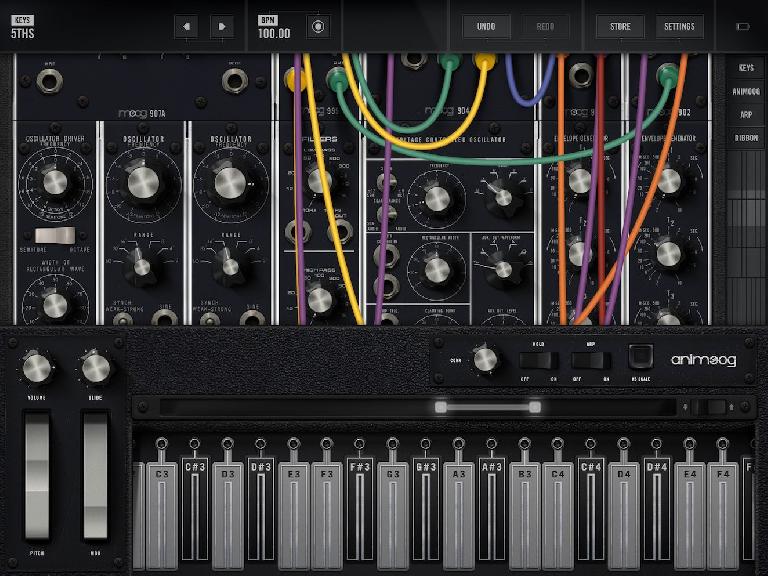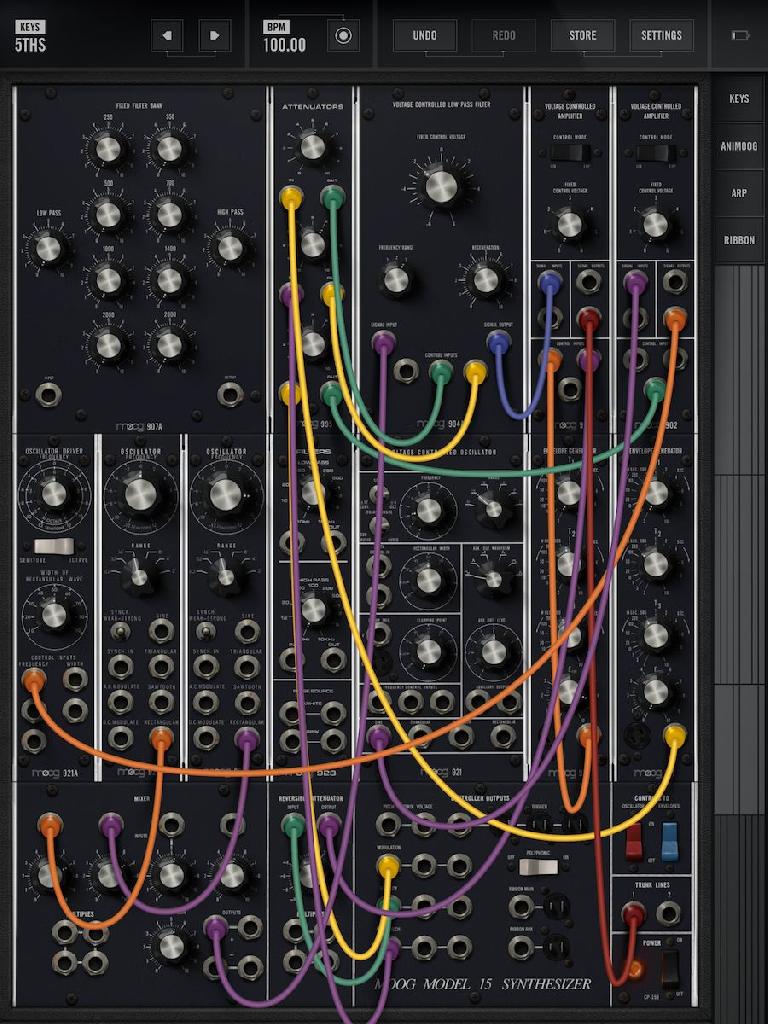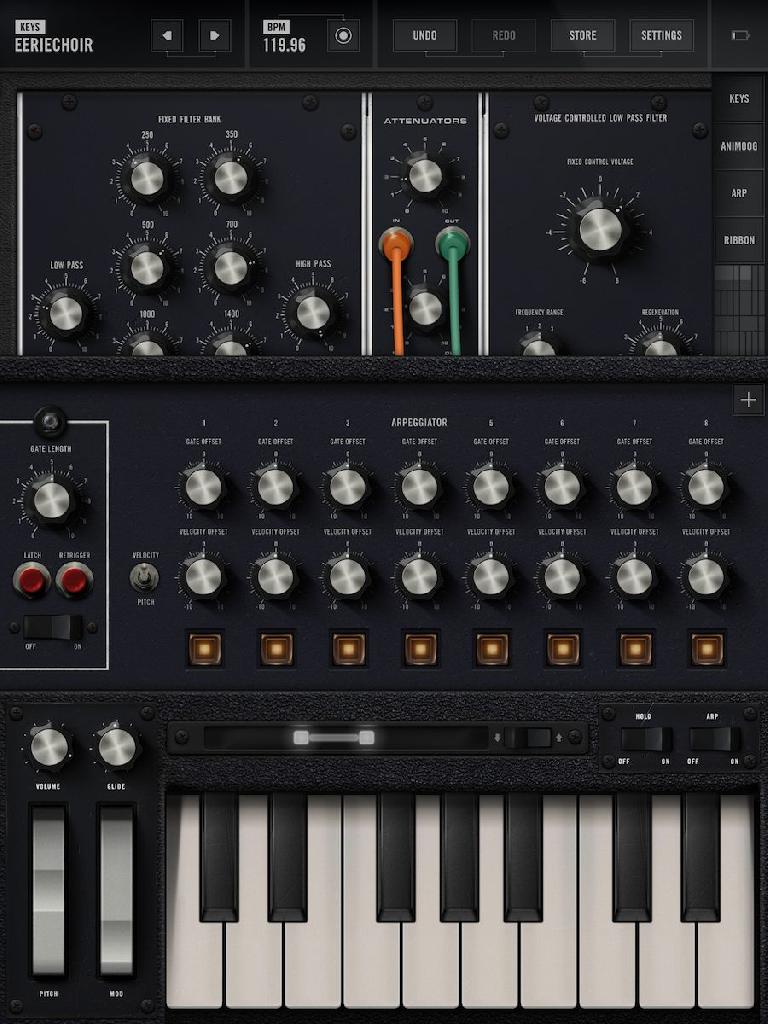Review: Moog Model 15, A New Standard for iOS Audio Apps
Rishabh Rajan on May 17, 2016 in Review | 4 comments
We are undoubtedly living in the golden age of synthesizers. Many vintage synths are being reissued. Many analog synth manufacturers are creating newer models at a very affordable price. The Eurorack format has opened up the modular world to the masses with more than 200 manufactures (https://www.modulargrid.net/e/vendors) creating all kinds of modules for every possible permutation and combination. Let’s also not forget the plethora of software emulation plugins of analog synthesizers along with modern digital synths. Since the Apple iPad’s release in 2010, there has been a significant number of synth manufacturers also developing iOS versions of their synths. Now Moog has entered the world of iOS modular synthesis with a faithful recreation of their Model 15 modular system specifically for the iPad, iPhone & iPod Touch.

User Interface
This is one of the more aesthetically pleasing & ergonomic iOS synths I have used. The interfaced can be zoomed into and navigated around using the standard 2 finger pinch & scroll gestures. Considering the amount of controls packed into the interface, it’s very helpful to have such zooming capabilities. Comparatively, the Korg iMS-20 app lacks in this department and can seem quite intimidating to new users. In fact, when using the iPad with a keyboard connected, you can even use key commands for zooming and navigating the interface of the Model 15. The built-in manual has all the available key commands listed. Double-tapping on the interface will dim all the connected patch cables, making it easier to look at control labels. What you will also notice while zooming into the interface is that the detail in the background, knobs and patch cables is astounding. It also doesn’t feel sluggish while scrolling around. This is all possible because it uses the relatively new Apple Metal API for Graphics (https://developer.apple.com/metal/). With this technology all the graphics related processing is offloaded to the GPU which leads to a more optimized performance for the CPU. So the CPU is dedicated to taking care of all the audio calculations and it does not have to worry about the graphics.
One drawback of this app is that it’s not true multitouch when it comes to knob control. You can’t control multiple dials simultaneously. This is quite a common way of using a real modular where both your hands are used to control 2 different parameters of the synth. I hope in a future update Moog implements true multitouch for at least up to 2 pots being controlled simultaneously.
Moog's Model 15 Synthesizer is a game changer. A fantastic app that will only get better.
Modules Included
This app is a recreation of the Moog Model 15 hardware modular synthesizer. These are the main modules of the Model 15:
- 921, 921A & 921B: Voltage Controlled Oscillators
- 904A: Voltage Controlled Low Pass Filter
- 907A: Fixed Filter Bank
- 923: Non-Resonant Low Pass & High Pass Filters, White & Pink Noise generator
- 995: Attenuators
- 902 (2 modules): Voltage Controlled Amplifier
- 911 (2 Modules): Envelope Generator
- Mixer Panel: 4 Inputs, 2 original and 2 polarity inverted outputs & Multiples
- Reversible Attenuator: Polarity inverted attenuator & Multiples
Control Modules:
- Keys: Standard Keyboard module similar to the original 952 Keyboard Controller.
- Animoog: Animoog’s controller with options for setting scales.
- Arp: 8-step tempo syncable Arpeggiator
- Ribbon: Ribbon controller based on the original 1150 Ribbon Controller

Additional Modules:
- Audio Bridge: Receive external audio to be processed by the Model 15 or send audio out to other apps.
- MIDI Bridge: Send and receive MIDI CC messages to control or be controlled by external controllers.
- Delay Effect: A clock syncable Delay module that processes the main output(Trunk Lines) of the Model 15.
- Recorder: Record, loop, overdub and export audio.
Audio Engine
It's hard to find words to explain the feeling one gets when listening to the audio from this device. Even if you have never heard a real Model 15, listening to the audio coming out of this app is a joyous experience. It’s almost hard to believe that such sounds can originate from an iOS device!
Since this app models all the saturation and nuances of each of the modules from the original hardware synth you get a very true representation of what a Moog modular sounds like. I would recommend listening to the output of this app through a high-quality audio interface like Apogee’s Duet for iPad or an audio pass through device like the iConnectMIDI. But even if you can’t do any of that and listen to the app through the iOS device’s headphone out, you will still hear some of that analog goodness which you may not on other apps.
Here’s an example of a 921B sawtooth oscillator running through the 904A Low Pass Filter with an envelope modulating the filter cutoff and some delay on the overall sound.
Now, there are some limitations to the sound. While modulating the oscillators or filter cutoff at audio rate the sound is a bit controlled and unlike what you would normally expect from an analog synth. In other words, the sound doesn’t really break apart and scream like it does on a hardware analog synth.
Here’s an example of an audio rate sine wave oscillator modulating an audible sawtooth oscillator. I am using an attenuator to control the depth, and I’m changing the rate of the sine wave with the octave switch and the frequency dial.
Now personally, if this is the difference between a $30 iOS app and a $10,000 hardware synth, I’ll gladly accept.
Polyphony
The original Model 15, like most modular synths was monophonic. The Model 15 app can be literally switched to become 4-note polyphonic. So with this you essentially get 4 Model 15s running simultaneously! I don’t know much about iOS programming but the Moog programmers have achieved quite a feat by giving us this feature without compromising on the sound quality.
Here’s an audio example of the Model 15 in polyphonic mode with all 3 oscillators including the auxiliary out on the 921
Ableton Link
Considering that Ableton Link is a relatively new technology, it’s quite impressive to see the feature built-in the Model 15 app. With Ableton Link enabled the Model 15 can sync to any other devices with Link enabled. Any tempo changes will translate over to all the devices. All this is done wirelessly and without the hassle of intricate setting up and third-party applications.
Audio & MIDI Bridge
It’s become a standard to see Audio Bridge & MIDI Bridge support on most iOS synths and audio apps. So with this you can route audio & MIDI in and out of the app. What is really great is that there is support for 14-bit MIDI, so you can get a much higher resolution while controlling the Model 15 with external controllers.
Educational Aspect
This is definitely one of my favorite features of this app. Moog has built in Tutorial Presets which guide you step by step on how to use the synth. There are currently only 2 Tutorial Presets (Signal Flow Part 1 & 2) but it is possible for end users to create these tutorial presets. Learning and teaching modular synthesis just got really intuitive and hands on. Expect to see a bunch of tutorial presets from me in the near future.
Competition
The Model 15 is definitely not the first modular synth iOS app. Jasuto and Audulus are a couple I have used. These two apps embrace the touch screen platform and give you a very futuristic user interface and almost endless patching possibilities. Since the Model 15 app is emulating a vintage hardware modular, we can’t really compare design attributes. But in terms of analog emulation and sonic quality, the Model 15 wins hands down. Comparing this app with some desktop plugins like the Modular V by Arturia, I would still put the Model 15 a step above, considering how buggy the Modular V is and also how uninspiring the user experience is when working with the computer mouse and trying to decipher the unintelligible labeling of the Modular V.
A good comparison with Model 15 is the Korg iMS-20. Personally I am a fan of the iMS-20. It too is a great emulation of a classic hardware semi-modular synth. The user experience is still much better on the Model 15 but the iMS-20 is also a great sounding app and it would definitely be worth having both. Keep in mind the iMS-20 is a semi-modular synth so you will be able to do a lot more with a fully modular synth like the Model 15. Also, the sound of a Korg synth is very different from that of a Moog synth which is generally attributed to the filter design so it would be again hard to compare the two. Lastly, the iMS-20 app is strictly monophonic while with the Model 15 you can get 4-note polyphony.

If you have an older device, it might just be worth upgrading just to use Model 15!
Compatibility
This is one area where some users might be disappointed. The Model 15 only supports 64-bit devices so iPad Air and above, iPad mini 2 and above, iPad Pro 12.9 inch, iPhone 5S and above, iPod Touch (6th Generation). I used the app on an iPad Air and surprisingly there were absolutely no issues. The only anomaly I observed was the iPad would get a bit warmer than usual. If you have an older incompatible device, it might just be worth upgrading just to use this app. Regarding the OS, it does require the most recent iOS 9.3.1.
Conclusion
When Animoog was released there was a lot of excitement about the first synth app from Moog. In fact, my first course for macProVideo & AskAudio Academy was on the Animoog. Now, that excitement has doubled. The Model 15 is a game changer. A fantastic app that will only get better. Don’t think of this as a side-project that Moog would work on once in 5 years. Its only been a few days since the Model 15’s release and there is already an update available. Moog has a dedicated team working on iOS apps. You can contact them for any tech support needed for the Model 15 appsupport@moogmusic.com. They haven’t mentioned any future development plans but I wouldn’t be surprised if there are more apps released in the future. All in all, great news for everyone alive and making music with synthesizers today.
Price: $29.99 USD
Pros: Very close virtual recreation of a $10,000 hardware modular for the iOS platform, Very slick GUI for a blissful user experience, useful Tutorial Presets.
Cons: Only supports iPad Air and above.




 © 2024 Ask.Audio
A NonLinear Educating Company
© 2024 Ask.Audio
A NonLinear Educating Company
Discussion
You said "Now, there are some limitations to the sound. While modulating the oscillators or filter cutoff at audio rate the sound is a bit controlled and unlike what you would normally expect from an analog synth. In other words, the sound doesn’t really break apart and scream like it does on a hardware analog synth."
This is false. Here is a example of the Model 15 doing these sounds: https://www.dropbox.com/s/sfy4yx8b1ugg2w6/model15%20-%20Recorder%2837%29.wav?dl=0
Here is the patch:
https://www.dropbox.com/s/1fkmer7uxz772hg/DEEP%20FM.m15p?dl=0
Audiohub said:
Audiohub May 7
"I've got another question for the Moog guy, although I haven't seen him posting here lately.
Are you still monitoring this forum?
I've noticed that the most that you can increase the frequency of the two 921b oscillators by using the DC Modulate jacks is just 1 octave up or one octave down. This seems broken, as it severely limits the ability to do useful FM by modulating one 921b with the other, and also really limits the hard sync tonal range if you're modulating the synced oscillator with an envelope generator for that classic sync sound.
On a hardware 921b module, the oscillator can be modulated much farther than this, allowing it to create a much wider range of sounds.
Can this be fixed?
Also, thanks for your previous answer about normalling the inputs of the 3 reversible attenuators. Although I agree that this isn't part of the recreation of a vintage model 15, I still hope that you might consider it in a future update because of its usefulness.
I don't really see this app as a slavish recreation of the 15, because it really is a lot better in a number of ways, what with the Midi and Audio patchbay, the Voltage Controlled delay, Voltage Controlled reversible attenuators (I don't think Moog ever made these for the Modulars, although they certainly should have) and even nice touches like including the hard sync to replace the less useful strong sync that was on the original 15.
There is a neat trick you can use to extend the range of the 921b modulation...
If you use an app like MidiBridge, you can route the Model 15 Midi Out to the Model 15 Midi In.
Now, you can route the envelope generator to, say, the CC 16 Midi Out on the Midi panel. If you assign the oscillator Frequency knob to CC 16, now you can go 2 octaves up and down. Better, but still not great.
You can also assign CC 16 to the Oscillator Range switch (yes, you can assign the same CC# to multiple destinations if you want) and now you can push the frequency up via the envelope generator quite a bit!
Not very convenient, but for the determined programmer with access to an app like MidiBridge, there are at least some options available."
MoogMusicInc. replied:
"We'll look into this, but if memory serves well the DC modulate input is indeed limited between -1V and +1V in the hardware specifications of the 921B. The AC modulate input doesn't have this limitation."
Audiohub replied:
Audiohub May 7
"Nice to see that you're here! Much appreciated!
I just went and fired up the hardware Modular, and you are indeed correct!
Somehow I was sure that that input had a much wider range, but in reality, mine can only be pushed about 1 1/3 octaves before it rails out. The AC modulate on the app doesnt seem to go any further, although since it's AC coupled that makes it harder to tell if you use the envelope generator (it won't stay at pitch as the cap simulation blocks DC)."
Original post link: https://forum.audiob.us/discussion/13406/moog-model-15-app-released/p19
Also, I should have defined clearly what I really meant by 'break apart'. I suppose on any level once the sound is Frequency Modulated, it does break apart. Just like in your example. But I was talking about how it happens on a system where the FM Index is not limited to such a narrow range. For example in the Eurorack world, a module like the Make Noise DPO just obliterates the sound when the exponential FM Index is up.
Want to join the discussion?
Create an account or login to get started!